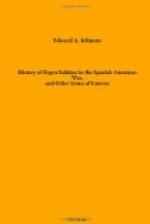“Now, I want to say just a word more to some of the men I see standing around not of your number. I refer to the colored regiments, who occupied the right and left flanks of us at Guasimas, the Ninth and Tenth cavalry regiments. The Spaniards called them ‘Smoked Yankees,’ but we found them to be an excellent breed of Yankees. I am sure that I speak the sentiments of officers and men in the assemblage when I say that between you and the other cavalry regiments there exists a tie which we trust will never be broken.”—Colored American.
* * * * *
The foregoing compliments to the Negro soldiers by Colonel Roosevelt started up an avalanche of additional praise for them, out of which the fact came, that but for the Ninth and Tenth Cavalry (colored) coming up at Las Guasimas, destroying the Spanish block house and driving the Spaniards off, when Roosevelt and his men had been caught in a trap, with a barbed-wire fence on one side and a precipice on the other, not only the brave Capron and Fish, but the whole of his command would have been annihilated by the Spanish sharp-shooters, who were firing with smokeless powder under cover, and picking off the Rough Riders one by one, who could not see the Spaniards. To break the force of this unfavorable comment on the Rough Riders, it is claimed that Colonel Roosevelt made the following criticism of the colored soldiers in general and of a few of them in particular, in an article written by him for the April Scribner; and a letter replying to the Colonel’s strictures, follows by Sergeant Holliday, who was an “eye-witness” to the incident:
Colonel Roosevelt’s criticism was, in substance, that colored soldiers were of no avail without white officers; that when the white commissioned officers are killed or disabled, colored non-commissioned officers could not be depended upon to keep up a charge already begun; that about a score of colored infantrymen, who had drifted into his command, weakened on the hill at San Juan under the galling Spanish fire, and started to the rear, stating that they intended finding their regiments, or to assist the wounded; whereupon he drew his revolver and ordered them to return to ranks and there remain, and that he would shoot the first man who didn’t obey him; and that after that he had no further trouble.
Colonel Roosevelt is sufficiently answered in the following letter of Sergeant Holliday, and the point especially made by many eye-witnesses (white) who were engaged in that fight is, as related in Chapter V, of this book, that the Negro troops made the charges both at San Juan and El Caney after nearly all their officers had been killed or wounded. Upon what facts, therefore, does Colonel Roosevelt base his conclusions that Negro soldiers will not fight without commissioned officers, when the only real test of this question happened around Santiago and showed just the contrary of what he states? We prefer to take the results at El Caney and San Juan as against Colonel Roosevelt’s imagination.




